#the general formula of scooby doo very fun
Text
hey so mystery incorporated fucks actually and i have no idea why i didn’t watch this as it was airing? my best guess is i was just so fucking jaded by the turn the straight to home movies took that i went “wow actually fuck scooby doo”.
#i watched a lot of what's new scooby doo because i find like#the general formula of scooby doo very fun#but i will admit that the turn the films took really bummed me out#those first three were so fucking good and then cyberchase happened#and then everything after that was like 'why not what's new scooby doo for 90s minutes?'#i have scooby doo thoughts and opinions
3 notes
·
View notes
Note
I feel like you’ve answered this before but: what Scooby-Do stuff would you recommend to someone who wants to get into Scooby-Do?
hi!! i'm basing my recommendations mostly on what i think would be good entry points for people who haven't seen a lot of scooby-doo, so most of this is older (pre-2010s) scooby-doo stuff bc a lot of newer scooby media references older stuff. the first half of this list is tv shows, the second half is movies.
scooby-doo, where are you? (1969-1970)
this is the original series, i still love it so much - it's very 1969 but not entirely in a bad way, and i'd say it's an important watch if you want to really get into scooby-doo. most other scooby media ends up directly referencing it in some way (frequently by mentioning the most memorable antagonists from the series) and it gives you a nice idea of the characters and the general formula of scooby media. it's episodic so you don't have to watch it in any specific order, and you don't have to watch all of it if you don't want to - just a couple episodes should do the job for a good entry point!
what's new, scooby-doo? (2002-2006)
this was the first major scooby-doo series that returned to the original formula of "where are you?" and it's a good entry point because it follows the same formula as the original, just more 2000s this time. this one's also super cute, and it's highly episodic like the original, so you can watch it in whatever order. unlike the 1969-70 cartoon, though, mystery inc takes their adventures all across the world in this one, which adds a nice twist to the formula. this is probably my favorite of the scooby-doo tv shows!
a pup named scooby-doo (1988-1991)
the scooby gang is back, but they're in elementary school this time! this is a nice tv show because the animation style is absolutely adorable and the plots are for the most part very similar to the original, but there's a nice originality to the style and some fun running jokes that always make me smile. the theme song also goes so hard <3
scooby-doo and the witch's ghost (1999)
not only is this one of the best scooby-doo movies ever (animation, story, villain, twists, music, characterization of the gang, all peak!!) but it also introduces the hex girls who are basically a staple of scooby-doo lore. this is also a velma-centric film and it's just really, really good, i highly recommend! it's a solid entry point because it's of a pretty standard formula for maybe half of the scooby-doo movies that currently exist, but it's still nice and original and fun to watch.
scooby-doo: the mystery begins (2009)
this movie's pretty good because it provides a version of a backstory for mystery inc - of course, there are lots of different takes on the gang's backstory bc of how much scooby-doo stuff there is in the universe, but this is a good entry-point one. we meet the members of mystery inc in high school as they slowly start to become friends over the shared interest of solving a local mystery. it's a made-for-tv movie, so it's nice and short, and hayley kiyoko's also in it as velma which is cool as hell. of course, it's not perfect, but i still really like it! it also follows the standard scooby-doo formula pretty well, which is nice.
scooby-doo: abracadabra-doo (2010)
this is one of my favorites of the newer scooby-doo movies. it's also pretty standard and i think it introduces the scooby-doo formula and the gang pretty well. it's also neat because instead of a humanoid villain, the antagonist is a gryphon, which is pretty cool! it also takes place at a magic school. there's a lot of neat stuff in this that i really like, and it feels like the writers and animators had a lot of fun with it - i just really like this one tbh, highly recommend!
also, here's a list of my top 10 favorite pieces of scooby-doo media! it's not quite the same as what i think would be good entry points, so i wanted to include it separately.
95 notes
·
View notes
Text
Be-Cool Scooby-Doo is the most entertaining 2010′s series in the franchise
I’ve been on a Scooby-Doo mood recently because of the newest DTV coming out, and have watched episodes of the last 3 shows. For some reason, Mystery Incorporated has now gathered a resurgence on some reaction channels on Youtube. I had stopped watching Be Cool because I had no idea which episodes I had seen and hadn’t and wanted to refresh my memory. Guess Who, I hadn’t seen much of other than one off episodes since it premiered so I wanted to check it out.
Watching episodes of these iterations back to back, Be Cool was the one of them that I most wanted to keep watching
First, Mystery Incorporated, there is a lot to say about this that’s unpopular
It’s hard for me to get into because there’s way too much romance focus for the gang that takes away from the interesting overarching story. Knowing that story culminates in any bad thing that anyone did was because of an evil entity controlling everything makes the story feel pointless. Since the universe completely reset, nothing that happened in the show matters. It tried too hard to be an edgy-teen romance show that it stopped being a Scooby-Doo show. All the drama at the beginning makes you wonder how exactly they even became a team in the first place at all.
People say it gave them personality, Fred loving traps to a basically romantic level is not a personality, Daphne being head over heels and overfocused on Fred is not a personality. The Velma/Shaggy stuff is horribly written and I’m not gonna excuse it because of an instagram comment made a decade after the show aired. Velma is completely controlling and toxic towards Shaggy asking him to choose her or Scooby. When Shaggy does choose Scooby, the show frames it as if you should be feeling sad for Velma. Any tension between them in the season frames Shaggy in the wrong for breaking it up. And instead of referencing how Velma acted was wrong...they just never mention it again in S2
Then for Guess Who?
It has the opposite issue of being too safe. It has some fun moments but it’s basically just The New Scooby-Doo Movies with modern stars and in half the timeframe. When only one character is talking, the rest of the characters just stand in poses almost creepily still. Most of the designs are fine, but for some reason Daphne’s model seems weird to me. In those pose moments, Daphne will either look like she has a very wide smile or for some reason agitated.
One big issue is that this show focuses so heavily on the guest star and chase sequences that it doesn’t have time for the actual mysteries. One thing I do appreciate about this show is the unique takes on the Scooby-Doo Doors trope. They do it every episode and you can tell it’s the part the crew had the most fun doing
I will say I did enjoy the meta episode of them meeting their voice actors. You can tell the cast had a realy fun time with that one and the last line of Scooby thanking Frank Welker for everything is a really sweet note to end on.
Finally, Be Cool
This show does a really good job of keeping the episodic formulaic nature of the franchise, but keeping it fresh and funny for the modern day. Having a more wacky humor fits the very different art style it has. For me, it’s impossible to have come out of watching one of these episodes and not having enjoyed it in some way.
They do the Fred idea way better in this one, where instead of being obsessed with traps he’s obsessed with mysteries in general and the obsession doesn’t go to the weird romantic level MI does with Fred. But besides the obsession, he isn’t stupid and is the leader of the team Daphne being the wild card in the group is a lot more entertaining to watch then her MI counterpart. Scooby is kept to saying like 4 or 5 words for one-liners and it really works in his favor.
Shaggy and Scooby are at their best in this show as well, especially with the moments where they trick the creature. You can tell the writers had a really fun time with that trope.
To me this iteration feels like a real group of friends that care about each other even if they get annoyed at each other.
You can tell the crew of this show the franchise and is important to them to stay true to the original roots while still being able to be poke fun at the conventions of it, but it’s never done in a demeaning way.
The art style does take a little getting used to it, but everything else about the show makes up for it and you might even like the style. Also compared to Guess Who stock poses, the other characters actually react to people speaking instead of just standing there still. There’s always something you didn’t notice the first time around when watching these episodes.
All 3 of these shows had 2 seasons and 52 episodes, but Be Cool, Scooby-Doo is the one that I personally think deserved a longer run.
#scooby-doo mystery incorporated#be cool scooby doo#scooby doo and guess who#scooby doo#sdmi#bcsd#sdgw
23 notes
·
View notes
Text
One of the most baffling criticisms of Scrappy
There are some who don’t like his character, that’s fair, he won’t appeal to everyone. There are some who don’t like the shows that he appeared in, that’s fair.
Most Scrappy criticisms are fair because not everyone will like the same thing. But then there are people who will say something “Scrappy’s role is just a mish mash of the others” “Scrappy can’t do anything useful that the others can’t provide”. It feels to me like they’re saying Not only is that untrue, but I feel like what makes this argument truly unfair is how it completely perverts the very nature of storytelling itself. It’s true the franchise has a general formula, but remember in the years that formula has shown an ability to be flexible, poke fun at itself, and shift and ebb as needed. Because, even with a format, Storytelling isn’t some kind of chemical equation where everyone “needs” to fill a role. These people are utterly sterilizing the writing process because for some reason they feel the need to justify their love for the original show and their dislike for Scrappy.
Ironically, however, they actually are hurting their own argument. Nobody watches a show just to watch a series of entities perform a series of roles without flair or emotions. YES SCOOBY HAS A FORMULA, but what that’s what makes the series malleable, not what solely defines it. What makes it entertaining is humor, friendship, and the appeal of demystifying The Things That Go Bump In The Night. Or humor and friendship for 80′s stuff (but 2/3 ain’t bad, to me, at least) Nobody, not the people making this argument, watches a show just to watch a series of narrative devices perform a series of roles merely for the sake of it.
Really, why waste your energy even hating a miscalculated compilation of different devices and roles? I don’t doubt you dislike Scrappy and prefer Scooby-Doo your way, but your argument, as though Scrappy’s existence is only worth the sum of the roles he can perform, actually demeans the show itself and all the characters in it. If it’s as simple as that, then you need to rethink your view on television shows in general.
#discourse#scrappy#the whole 'whatever scrappy does we can have Fred or Velma do'#bro Scrappy Fred and Velma are three separate entities#they are characters intended to live in a world not machines carrying out 'functions'#you may like the second two more then the first but by making this argument you're actually diminishing all three of them#I don't think you're even making the argument you're thinking about
3 notes
·
View notes
Text
TAG NINE PEOPLE YOU’D LIKE TO KNOW BETTER!

favourite colour(s): Purple
favourite genre(s): I'm a big fan of action and adventure stories. Horror and monster stories too...Tokusatsu stuff...I could go on.
favourite music: I'm a pretty big fan of classic rock. DIO is definitely my favorite artist/band though.
favourite movie: Probably Suburban Sasquatch or Robo Vampire. I'm a sucker for really poorly made garbage. If we're talking about actual quality...Probably John Carpenter's: The Thing. Pretty basic answer for horror, but it's damn good.
favourite series: If we're talking video games, it's probably the Sly Cooper games. Or at least the original trilogy. Lots of good memories with those. For shows, I'd say Gurren Laggan. I could rewatch it a million times and still enjoy it. In general, it would have to be Scooby-Doo. I love that formulaic dog show...
last song: I played Omori recently and World's End Valentine has been a brainworm that will not leave me.
last series: I watched Toradora for the first time. Good show.
last movie: Shin Ultraman. It was goofy and very enjoyable. Looking forward to Kamen Rider next year.
currently reading: I'm not much of a book guy, but if we're counting manga, I've been reading Spy x Family. Really looking forward to picking up the newest English volume when I go to the bookstore next.
currently watching: My friend and I are watching Lucky Star right now. It's pretty fun. I'm especially enjoying the Lucky Channel end segments.
currently working on: There are a few drafts that I still need to get done. Hoping to get those done either Thursday or this weekend. My will to write comes and goes, so we'll see!
tagged by: @dcviated
tagging: I think the only mutual of mine that I haven't seen get tagged is @more-than-a-princess, so I'll just say them and anyone else who sees this!
1 note
·
View note
Text
⚔️ I WATCHED THE SWORD AND THE SCOOB YEAHFGSHDG (some spoilers ahead)
i’m from the uk so it was really funny to see the gang do all the classic british tourist-y things. the double-decker buses. the phone boxes. the stone circles. the food jokes were great because you had things like fish and chips/tea and scones but then also things like toad in the hole (yes), spotted dick (yes again), and jellied eels (the uk is great). absolutely stellar content
girlboss knight daphne is the only thing that matters to me anymore. “sir daphne, you’re my knight in shining armour!” added 1000000 years to my lifespan. was not expecting “i told you reality is a simulation” to be the penultimate line of a scooby doo movie but thank you daphne very cool
i can’t believe they referenced mayor jones. i can’t believe that velma said king arthur was like an authoritarian dictator and then fred just went “oh, like my dad! :)” and then daphne agreed and they left it at that. Man. though in general i love the subtle ties back to mystery incorporated, they’re never overdone and really help the franchise feel a little more interconnected!
the comedy is (mostly) really sharp, and the character interactions are a lot of fun! i never thought i would say that almost Actual King Arthur has great chemistry with mystery inc as an unofficial sixth member but here we are.
my only criticisms would be that the pacing felt kind of awkward in places, and a little part of me wishes that they actually did travel to camelot. i’m a sucker for time travel plots, and the fading lockscreen photo reminded me a lot of back to the future!! so in that way it was a shame that it was all a hoax, but a fun one regardless.
i was looking forward to watching this one for a really long time and it definitely didn’t disappoint. i adore arthurian mythos, so it was really cool to see a crossover between two of my biggest interests in that way!! it was a really fun take on the classic story that still worked really well with the scooby characters and formula. 9/10, i would definitely watch it again! :D
27 notes
·
View notes
Photo
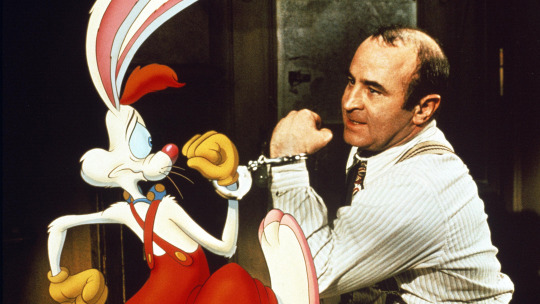
Blurring the Line.
As a new Space Jam film beams down to Earth, Kambole Campbell argues that a commitment to silliness and a sincere love for the medium is what it takes to make a great live-action/animation hybrid.
The live-action and animation hybrid movie is something of a dicey prospect. It’s tricky to create believable interaction between what’s real and what’s drawn, puppeteered or rendered—and blending the live and the animated has so far resulted in wild swings in quality. It is a highly specific and technically demanding niche, one with only a select few major hits, though plenty of cult oddities. So what makes a good live-action/animation hybrid?
To borrow words from Hayao Miyazaki, “live action is becoming part of that whole soup called animation”. Characters distinct from the humans they interact with, but rendered as though they were real creatures (or ghosts), are everywhere lately; in Paddington, in Scooby Doo, in David Lowery’s (wonderful) update of Pete’s Dragon.
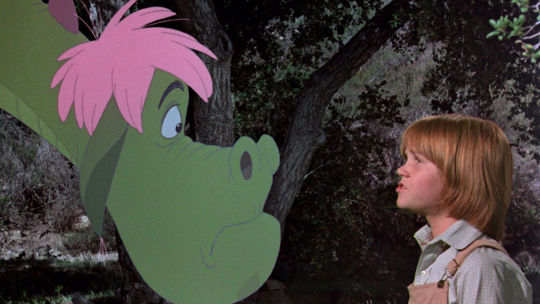
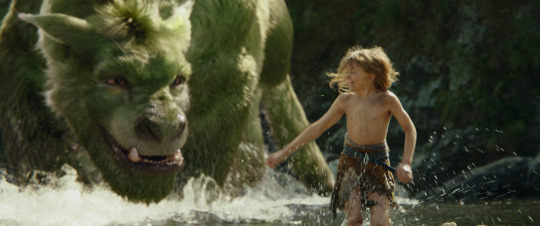
The original ‘Pete’s Dragon’ (1977) alongside the 2016 remake.
Lowery’s dragon is realized with highly realistic lighting and visual-effects work. By comparison, the cartoon-like characters in the 1977 Pete’s Dragon—along with other films listed in Louise’s handy compendium of Disney’s live-action animation—are far more exaggerated. That said, there’s still the occasional holdout for the classical version of these crossovers: this year’s Tom and Jerry replicating the look of 2D through 3D/CGI animation, specifically harkens back to the shorts of the 1940s and ’50s.
One type of live-action/animation hybrid focuses on seamless immersion, the other is interested in exploring the seams themselves. Elf (2003) uses the aberration of stop-motion animals to represent the eponymous character as a fish out of water. Ninjababy, a Letterboxd favorite from this year’s SXSW Festival, employs an animated doodle as a representation of the protagonist’s state of mind while she processes her unplanned pregnancy.
Meanwhile, every Muppets film ever literally tears at the seams until we’re in stitches, but, for the sake of simplicity, puppets are not invited to this particular party. What we are concerned with here is the overlap between hand-drawn animation and live-action scenes (with honorable mentions of equally valid stop-motion work), and the ways in which these hybrids have moved from whimsical confections to nod-and-wink blockbusters across a century of cinema.

Betty Boop and Koko the clown in a 1938 instalment of the Fleischer brothers’ ‘Out of the Inkwell’ series.
Early crossovers often involve animators playing with their characters, in scenarios such as the inventive Out of the Inkwell series of shorts from Rotoscope inventor Max Fleischer and his director brother Dave. Things get even more interactive mid-century, when Gene Kelly holds hands with Jerry Mouse in Anchors Aweigh.
The 1960s and ’70s deliver ever more delightful family fare involving human actors entering cartoon worlds, notably in the Robert Stevenson-directed Mary Poppins and Bedknobs and Broomsticks, and Chuck Jones’ puntastic The Phantom Tollbooth.

Jerry and Gene dance off their worries in ‘Anchors Aweigh’ (1945).
Mary Poppins is one of the highest-rated live-action/animation hybrids on Letterboxd for good reason. Its sense of control in how it engages with its animated creations makes it—still!—an incredibly engaging watch. It is simply far less evil than the singin’, dancin’ glorification of slavery in Disney’s Song of the South (1946), and far more engaging than Victory Through Air Power (1943), a war-propaganda film about the benefits of long-range bombing in the fight against Hitler. The studio’s The Reluctant Dragon (1941) also serves a propagandistic function, as a behind-the-scenes studio tour made when the studio’s animators were striking.
By comparison, Mary Poppins’ excursions into the painted world—replicated in Rob Marshall’s belated, underrated 2018 sequel, Mary Poppins Returns—are full of magical whimsicality. “Films have added the gimmick of making animation and live characters interact countless times, but paradoxically none as pristine-looking as this creation,” writes Edgar in this review. “This is a visual landmark, a watershed… the effect of making everything float magically, to the detail of when a drawing should appear in front or the back of [Dick] Van Dyke is a creation beyond my comprehension.” (For Van Dyke, who played dual roles as Bert and Mr Dawes Senior, the experience sparked a lifelong love of animation and visual effects.)
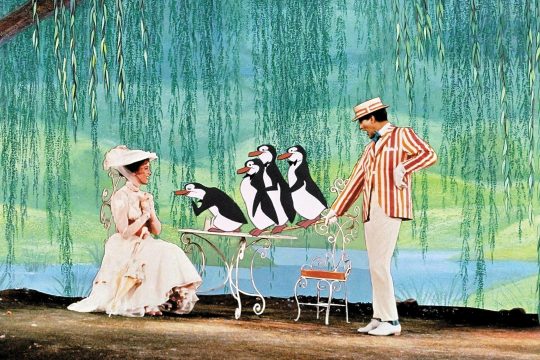
Julie Andrews, Dick Van Dyke and penguins, in ‘Mary Poppins’ (1964).
Generally speaking, and the Mary Poppins sequel aside, more contemporary efforts seek to subvert this feeling of harmony and control, instead embracing the chaos of two worlds colliding, the cartoons there to shock rather than sing. Henry Selick’s frequently nightmarish James and the Giant Peach (1996) leans into this crossover as something uncanny and macabre by combining live action with stop motion, as its young protagonist eats his way into another world, meeting mechanical sharks and man-eating rhinos. Sally Jane Black describes it as “riding the Burton-esque wave of mid-’90s mall goth trends and blending with the differently demonic Dahl story”.
Science-classroom staple Osmosis Jones (2001) finds that within the human body, the internal organs serve as cities full of drawn white-blood-cell cops. The late Stephen Hillenburg’s The Spongebob Squarepants Movie (2004) turns its real-life humans into living cartoons themselves, particularly in a bonkers sequence featuring David Hasselhoff basically turning into a speedboat.
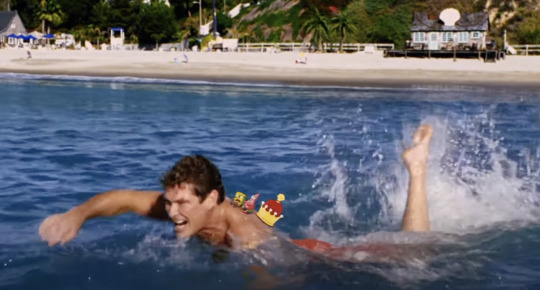
David Hasselhoff picks up speed in ‘The Spongebob Squarepants Movie’ (2004).
The absurdity behind the collision of the drawn and the real is never better embodied than in another of our highest-rated live/animated hybrids. Released in 1988, Robert Zemeckis’ Who Framed Roger Rabbit shows off a deep understanding—narratively and aesthetically—of the material that it’s parodying, seeking out the impeccable craftsmanship of legends such as director of animation Richard Williams (1993’s The Thief and the Cobbler), and his close collaborator Roy Naisbitt. The forced perspectives of Naisbitt’s mind-bending layouts provide much of the rocket fuel driving the film’s madcap cartoon opening.
Distributed by Walt Disney Pictures, Roger Rabbit utilizes the Disney stable of characters as well as the Looney Tunes cast to harken back to America’s golden age of animation. It continues a familiar scenario where the ’toons themselves are autonomous actors (as also seen in Friz Freleng’s 1940 short You Ought to Be in Pictures, in which Daffy Duck convinces Porky Pig to try his acting luck in the big studios).

Daffy Duck plots his rise up the acting ranks in ‘You Ought to Be in Pictures’ (1940).
Through this conceit, Zemeckis is able to celebrate the craft of animation, while pastiching both Chinatown, the noir genre, and the mercenary nature of the film industry (“the best part is… they work for peanuts!” a studio exec says of the cast of Fantasia). As Eddie Valiant, Bob Hoskins’ skepticism and disdain towards “toons” is a giant parody of Disney’s more traditional approach to matching humans and drawings.
Adult audiences are catered for with plenty of euphemistic humor and in-jokes about the history of the medium. It’s both hilarious (“they… dropped a piano on him,” one character solemnly notes of his son) and just the beginning of Hollywood toying with feature-length stories in which people co-exist with cartoons, rather than dipping in and out of fantasy sequences. It’s not just about how the cartoons appear on the screen, but how the human world reacts to them, and Zemeckis gets a lot of mileage out of applying ’toon lunacy to our world.
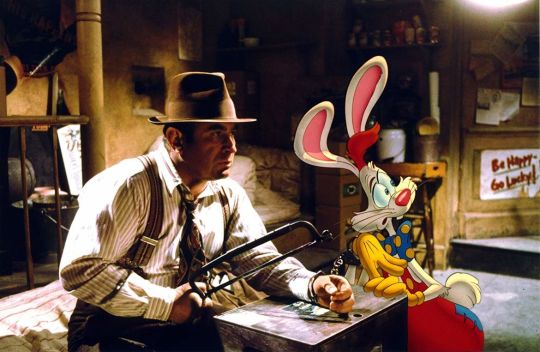
Bob Hoskins in ‘Who Framed Roger Rabbit?’ (1988).
The groundbreaking optical effects and compositing are excellent (and Hoskins’ amazing performance should also be credited for holding all of it together), but what makes Roger Rabbit such a hit is that sense of controlled chaos and a clever tonal weaving of violence and noirish seediness (“I’m not bad… I’m just drawn that way”) through the cartoony feel. And it is simply very, very funny.
It could be said that, with Roger Rabbit, Zemeckis unlocked the formula for how to modernize the live-action and animation hybrid, by leaning into a winking parody of what came before. It worked so perfectly well that it helped kickstart the ‘Disney renaissance' era of animation. Roger Rabbit has influenced every well-known live-action/animation hybrid produced since, proving that there is success and fun to be had by completely upending Mary Poppins-esque quirks. Even Disney’s delightful 2007 rom-com Enchanted makes comedy out of the idea of cartoons crossing that boundary.
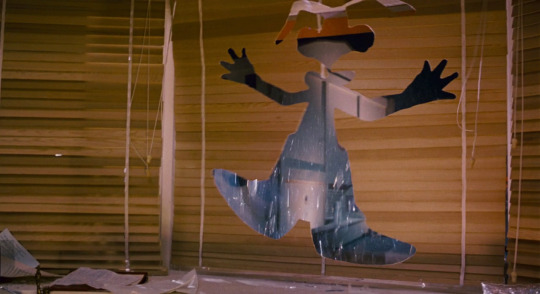
When a cartoon character meets real-world obstacles.
Even when done well, though, hybrids are not an automatic hit. Sitting at a 2.8-star average, Joe Dante’s stealthily great Looney Tunes: Back in Action (2003) is considered by the righteous to be the superior live-action/animated Looney Tunes hybrid, harkening back to the world of Chuck Jones and Frank Tashlin. SilentDawn states that the film deserves the nostalgic reverence reserved for Space Jam: “From gag to gag, set piece to set piece, Back in Action is utterly bonkers in its logic-free plotting and the constant manipulation of busy frames.”
With its Tinseltown parody, Back in Action pulls from the same bag of tricks as Roger Rabbit; here, the Looney Tunes characters are famous, self-entitled actors. Dante cranks the meta comedy up to eleven, opening the film with Matthew Lillard being accosted by Shaggy for his performance in the aforementioned Scooby Doo movie (and early on throwing in backhanded jokes about the practice of films like itself as one character yells, “I was brought in to leverage your synergy!”).
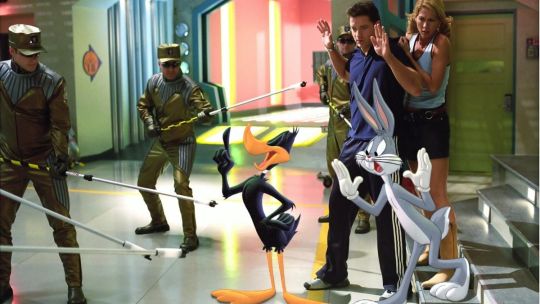
Daffy Duck with more non-stop banter in ‘Looney Tunes: Back in Action’ (2003).
Back in Action is even more technically complex than Roger Rabbit, seamlessly bringing Looney Tunes physics and visual language into the real world. Don’t forget that Dante had been here before, when he had Anthony banish Ethel into a cartoon-populated television show in his segment of Twilight Zone: The Movie. Another key to this seamlessness is star Brendan Fraser, at the height of his powers here as “Brendan Fraser’s stunt double”.
Like Hoskins before him, Fraser brings a wholehearted commitment to playing the fed-up straight man amidst cartoon zaniness. Fraser also brought that dedication to Henry Selick's Monkeybone (2001), a Roger Rabbit-inspired sex comedy that deploys a combo of stop-motion animation and live acting in a premise amusingly close to that of 1992’s Cool World (but more on that cult anomaly shortly). A commercial flop, Back in Action was the last cinematic outing for the Looney Tunes for some time.
Nowadays, when we think of live-action animation, it’s hard not to jump straight to an image of Michael Jordan’s arm stretching to do a half-court dunk to save the Looney Tunes from slavery. There’s not a lot that can be fully rationalized about the 1996 box-office smash, Space Jam. It is a bewildering cartoon advert for Michael Jordan’s baseball career, dreamed up off the back of his basketball retirement, while also mashing together different American icons. Never forget that the soundtrack—one that, according to Benjamin, “makes you have to throw ass”—includes a song with B-Real, Coolio, Method Man and LL Cool J.
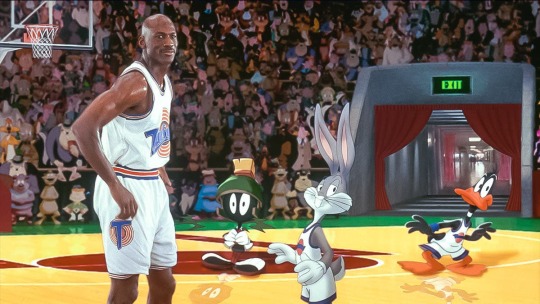
Michael Jordan and teammates in ‘Space Jam’ (1996).
Space Jam is a film inherently born to sell something, predicated on the existing success of a Nike commercial rather than any obvious passion for experimentation. But its pure strangeness, a growing nostalgia for the nineties, and meticulous compositing work from visual-effects supervisor Ed Jones and the film’s animation team (a number of whom also worked on both Roger Rabbit and Back in Action), have all kept it in the cultural memory.
The films is backwards, writes Jesse, in that it wants to distance itself from the very cartoons it leverages: “This really almost feels like a follow-up to Looney Tunes: Back in Action, rather than a predecessor, because it feels like someone watched the later movie, decided these Looney Tunes characters were a problem, and asked someone to make sure they were as secondary as possible.” That attempt to place all the agency in Jordan’s hands was a point of contention for Chuck Jones, the legendary Warner Bros cartoonist. He hated the film, stating that Bugs would never ask for help and would have dealt with the aliens in seven minutes.
Space Jam has its moments, however. Guy proclaims “there is nothing that Deadpool as a character will ever have to offer that isn’t done infinitely better by a good Bugs Bunny bit”. For some, its problems are a bit more straightforward, for others it’s a matter of safety in sport. But the overriding sentiments surrounding the film point to a sort of morbid fascination with the brazenness of its concept.

Holli Would (voiced by Kim Basinger) and Frank Harris (Brad Pitt) blur the lines in ‘Cool World’ (1992).
Existing in the same demented… space… as Space Jam, Paramount Pictures bought the idea for Cool World from Ralph Bakshi as it sought to have its own Roger Rabbit. While Brad Pitt described it as “Roger Rabbit on acid” ahead of release, Cool World itself looks like a nightmare version of Toontown. The film was universally panned at the time, caught awkwardly between being far too adult for children but too lacking in any real substance for adults (there’s something of a connective thread between Jessica Rabbit, Lola Bunny and Holli Would).
Ralph Bakshi’s risqué and calamitously horny formal experiment builds on the animator’s fascination with the relationship between the medium and the human body. Of course, he would go from the immensely detailed rotoscoping of Fire and Ice (1983) to clashing hand-drawn characters with real ones, something he had already touched upon in the seventies with Heavy Traffic and Coonskin, whose animated characters were drawn into real locations. But no one besides Bakshi quite knew what to do with the perverse concept of Brad Pitt as a noir detective trying to stop Gabriel Byrne’s cartoonist from having sex with a character that he drew—an animated Kim Basinger.
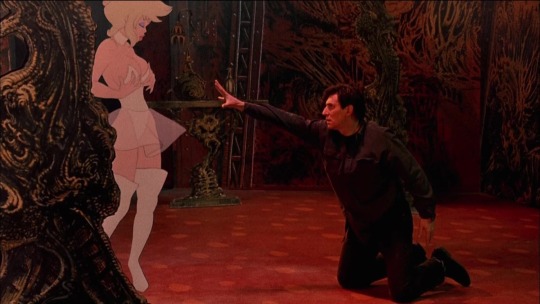
Jack Deebs (Gabriel Byrne) attempts to cross over to Hollie Would in ‘Cool World’ (1992).
Cool World’s awkwardness can be attributed to stilted interactions between Byrne, Pitt and the animated world, as well as studio meddling. Producer Frank Mancuso Jr (who was on the film due to his father running Paramount) demanded that the film be reworked into something PG-rated, against Bakshi’s wishes (he envisioned an R-rated horror), and the script was rewritten in secret. It went badly, so much so that Bakshi eventually punched Mancuso Jr in the face.
While Cool World averages two stars on Letterboxd, there are some enthusiastic holdouts. There are the people impressed by the insanity of it all, those who just love them a horny toon, and then there is Andrew, a five-star Cool World fan: “On the surface, it’s a Lovecraftian horror with Betty Boop as the villain, featuring a more impressive cityscape than Blade Runner and Dick Tracy combined, and multidimensional effects that make In the Mouth of Madness look like trash. The true star, however, proves to be the condensed surplus of unrelated gags clogging the arteries of the screen—in every corner is some of the silliest cel animation that will likely ever be created.”
There are even those who enjoy its “clear response to Who Framed Roger Rabbit”, with David writing that “the film presents a similar concept through the lens of the darkly comic, perverted world of the underground cartoonists”, though also noting that without Bakshi’s original script, the film is “a series of half steps and never really commits like it could”. Cool World feels both completely deranged and strangely low-energy, caught between different ideas as to how best to mix the two mediums. But it did give us a David Bowie jam.
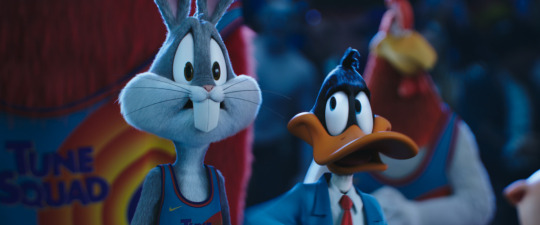
‘Space Jam: A New Legacy’ is in cinemas and on HBO Max now.
Craft is of course important, but generally speaking, maybe nowadays a commitment to silliness and a sincere love for the medium’s history is the thing that makes successful live-action/animation hybrids click. It’s an idea that doesn’t lend itself to being too cool, or even entirely palatable. The trick is to be as fully dotty as Mary Poppins, or steer into the gaucheness of the concept, à la Roger Rabbit and Looney Tunes: Back in Action.
It’s quite a tightrope to walk between good meta-comedy and a parade of references to intellectual property. The winningest strategy is to weave the characters into the tapestry of the plot and let the gags grow from there, rather than hoping their very inclusion is its own reward. Wait, you said what is coming out this week?
Related content
Rootfish Jones’s list of cartoons people are horny for
The 100 Sequences that Shaped Animation: the companion list to the Vulture story
Jose Moreno’s list of every animated film made from 1888 to the present
Follow Kambole on Letterboxd
#kambole campbell#mary poppins#ralph bakshi#hayao miyazaki#ghibli#disney#who framed roger rabbit#roger rabbit#spongebob squarepants#spongebob#animation#live action animation#live action animation hybrid#stop motion animation#stop motion#wes anderson#brad pitt#bob hoskins#genre#space jam#space jam a new legacy#michael jordan#lebron james#looney tunes#bugs bunny#daffy duck#warner bros#2d animation#letterboxd
25 notes
·
View notes
Note
i know almost nothing about lupin iii but it looks really fun from the stuff i've seen about it! it's a movie right? series of movies maybe?? what's it about?
It is fun! At least, so far as I’ve seen. I’ve barely seen much of it and will probably never see all the content out there that exists for it, but it’s been a good time!
It’s a long running franchise that basically started with a manga in the 60s (I think?) and has since gotten 5 different anime series and so many dang movies that I can’t even count them all. And a few miniseries spinoffs focusing on side characters (I know Zenigata has one at least, and I think Fujiko has one too?)
The nice thing about it though is that you don’t really need to know much about the series to break in, since it’s pretty much formulaic and doesn’t have an overarching plot where the Status Quo changes drastically. The movies (with maybe like two or three exceptions) are standalone, too. So you can pretty much just Pick A Thing And Go With It.
The plot is about a master thief (the titular Lupin) going about doing Crimes and stealing shit. And sometimes other stuff. He occasionally saves women or stops bad guys from doing Bad Guy Shit (the fact that he himself is technically a bad guy notwithstanding lol) but mostly it’s just him and his friends Causing Trouble For Funsies. In other words, it’s about what happens when you throw a thief, a samurai, a gunman, a femme fatale, and a beleaguered cop together and watch them Commit Hijinks
Personally I’d recommend if you’ve got Netflix watching The Castle of Cagliostro because it’s just easy to find and it’s a solid entry point, it gives you a good intro to the characters and is a very pleasant movie overall.
Or you can just watch the series on Crunchyroll. It doesn’t have any of the movies, but it has all 5 series. They’re titled Part 1, Part 2, etc. but they’re standalone and the “parts” are just the order they were made in. Evidently the “classic” series is actually Part 2. They do have some tonal shifts I know, I haven’t seen them all yet but Part 2 is very cartoonish (kinda reminiscent of Scooby-Doo or other shows from that era but for adults) whereas Parts 4 and 5 are more serious and darker in tone (I haven’t seen those ones yet though, and as for Parts 1 and 3 I have no idea what they’re like)
As for the movies... I’ve heard the CGI movie Lupin III: The First is amazing (the animation speaks for itself) but I haven’t seen it yet. It can be rented in the US though so it’s definitely viewable!
But otherwise here is a very good list covering every movie, its general premise, some content warnings/stuff to watch out for, and how generally dark and weird it is (they do range pretty drastically from what I understand). You’re on your own finding them though lol
Hopefully some of that helps! I hope I didn’t scare you off by pointing out the multiple series or movies - it’s really not that bad, and the nice thing is, you can pick and choose what you want to see so there’s anything that you don’t Vibe with, you can simply skip over it!
12 notes
·
View notes
Text
The Monster Behind The Mask: Remembering FRIDAY THE 13TH PART III
Friday the 13th Part III was released theatrically in the United States on Friday, August 13, 1982. 36 years ago tonight. Does that make you feel as old as Pamela Vorhees’ grey sweater? If the answer is a resounding ‘No, you fool – I was born in the 80’s, I had to wait at least a decade until I watched Jason mutilating camp counselors’, then welcome to this special look back on one of the more divisive Friday the 13th films. Grab your machetes, pull down your ice-hockey masks and don your wacky green/red 3-D spectacles, because we’re heading to Higgins Haven for some stabby-stabby fun with Jason Voorhees.
By the time Friday the 13th Part 2 (1981) came around in theaters, audiences had become swamped with low-quality slasher titles. Slasher film fatigue had set in hard, and although Jason’s second outing grossed over $21.7 million in the United States on a budget of $1.25 million, fans were disappointed with a rehashing of the original story, and it failed to pull in the original’s box office success. The fact that they gave no explanation to the ridiculous ending of Part II showed that the people in charge didn’t really put much value in the continuity or story progression. One thing everyone could agree on though: Jason needed to be scarier. He needed to be a real boogeyman. And to get there, there were going to need a gimmick to get that cold hard cash-vein open again. They needed…3D.
A New Dimension In Terror
The titles jumped out at you like Superman’s cosmic intro, only….cheaper looking. Not to mention a bombastic funky 70’s inspired theme that I totally dug, man. What you have to remember is that in 1982 although 3D film-making was still in its infancy (Jaws 3D anyone?) by 2010, it had become almost commonplace for any film released to be retrofitted for a new dimension of sight and sound. Friday the 13th Part III, however, paved the way for future 3D films. You may have a strong fondness for everything three dimensional, but for all the people that love donning plastic visors on their head the other bemoan the comically irritating ploy to cough up more money at the box office. I wear glasses and absolutely hate 3D films becuase it feels like I’m wearing glasses on top of glasses…which I am!
Unless you have your own pair of flimsy pre-revolutionary 3D glasses, (which I doubt you have) you’re going to see a lot of shots of people waggling sticks at the camera, having yo-yo’s thrown at them. You’ll also be treated to an overly long lingering shot of a crazy old man sticking an eyeball uncomfortably close to the screen. Steve Miner (who also directed Part II) returned to the director’s post to helm Friday the 13th: Part III and this new dimension of terror that continues straight after the events of Part 2.
.
The Higgins Haven Massacre
Just like its predecessor, the film opens with an extraordinarily long recap of the previous film. We see final girl Ginny (Amy Steel) running away from ‘Baghead Jason,’ trapped in the makeshift cabin Jason has been holed up in with his mother’s severed head lovingly affixed to a small alter. Ginny tricks Jason into thinking she’s his mother, by donning her sweater and generally berating the child-like minded serial killer. Before she can use her machete on him however, Jason sees his mummified mumma’s head and avoids her killing blow. Paul (John Furey) appears and begins wrestling with Jason. While Jason is distracted, Ginny hacks him in slow-motion with his own machete. They assume he’s dead, but we see Jason slowly moving off the screen. Cue: Opening Credits.
Originally, Friday the 13th Part III was supposed to focus on lone survivor Ginny Field, (Sorry, Paul) who checks herself into a mental institution after her traumatic escapade with the pillow-wearing, dungaree killer. The film would have been similar in that vein to the popular Halloween II (1981), with Jason tracking down Ginny in the hospital, but that idea was abandoned when actress Amy Steel declined to reprise her role. Perhaps she didn’t want to be typecast as the scream queen for this particular franchise, but by 1986 she was again up on screen evading a knife-wielding killer in the slasher parody April’s Fool Day (1986). There was also speculation that producers were worried fans would reject a Friday the 13th which didn’t follow the established formula.
I would love to find a script with this narrative, because the franchise may have steered in a different direction (or it could have died a horrible death right there and then). Every good franchise needs a protagonist the audience can root for. Alien (1979) had Ripley, A Nightmare on Elm Street (1984) had Nancy and Halloween (1978) had Laurie. You could argue that Friday the 13th had Tommy Jarvis, but he didn’t appear until the fourth installment. Looks like Steel missed the boat on this one if the powers that be really wanted her as the series’ Final Girl. With 12 films, a whole bunch of novels, video games, and the short-lived television series under their belt though. it looks like they went the right way.
Our new group of young victims are as follows: New Final Girl Chris (Dana Kimmell), ‘Spanish Phoebe Cates’ Vera (Catherine Parks), hot and steamy couple Debbie (Tracie Savage) and Andy (Jeffrey Rogers), hippie potheads Chili (Rachel Howard) and Chuck (David Katims), and franchise favourite, the lovable self-deprecating prankster Shelly Finkelstein (Larry Zerner).
The group arrives at Higgins Haven, a cottage (with a barn!) a mere stones-throw away from Packanack cabin, where the previous slaughter took place. The Scooby Doo/Cheech and Chong gang meet up with country farm boy Rick (Paul Kratka). It’s quickly established that he and Chris had a romantic tryst during their last summer at the lakeside cottage, and Rick instantly tries to get back to where things left off by feeling her up. Not cool, man. Not. Cool.
Chris explains that she wants to get to know him again but he responds that there are only so many ‘cold showers’ he could take. Wowzer. He essentially behaves like this for the entirety of the movie (bar one scene when Chris recounts a traumatic experience) but the weird thing is the filmmakers seem to want you to empathize with this guy – like he’s the hero of the movie. Film of the time, I guess?
After some tomfoolery from Shelley (and without the slightest irony of axe-wielding maniac foreshadowing), we’re introduced to a group of bikers that marks the first time in the franchise we’re introduced to black actors. It’s just a shame that they turn out to be scumbags. All the while, Jason’s been hiding in the barn, looking menacing from an over the shoulder perspective. He dispatches of the bikers when they arrive at the cottage to take their revenge on Shelley and the gang, following an altercation at a shop in town. Don’t assume that Jason is here to protect anyone though. He quickly sets his sights on the college co-eds and, of course, things really ramp up when he dons the now iconic ice hockey mask for the first time.
People will argue what their favourite Friday the 13th movie is until the end of days. Did you like the characterization of the teenagers in Part 2 or 4? Did you simply enjoy the hack n’ slash nature of the original? Were you excited when Jason went to Hell? Some people just want to watch cheesy 80’s effects and have some popcorn while devouring grisly death sequences with their eyes. But something doesn’t sit right with the third outing. They could have gone a much deeper, darker route with Chris‘ that might have lead Mr. Vorohees‘ down a very sketchy road. I’m obviously talking about…
The Final Girl
Late in the film, we see Chris and Rick sharing some quality catch-up time together. Up until this point Chris has been hinting that something terrible happened to her but now she’s finally ready to share her story. Even after Amy Steel declined to return, it’s safe to assume that some fragments from earlier drafts were kept to highlight Ginny’s (now Chris’s) trauma from the previous movie.
Chris explains that, while on vacation, she came home late one night which caused her to have an argument with her folks. She fled her house and ran into the woods where she fell asleep under a tree. Some time later, she was awoken by the sound of footsteps. The footsteps belong to none other than Jason and he grabs at her legs as she struggles to get away. She goes on to explain that she woke up in her own bed the following morning, without any recollection of what transpired after she was captured.
So what happened here? It’s unlikely that she would have survived an attack by Jason, so how did she escape? The series has been known for its nonsensical dream sequences and poorly crafted plot devices, but this is a pretty big moment for Jason. There are theories that she was raped by Jason and there are novels that further explain the story, but some people on the film claim this ambiguous resolution was always planned since actually outright calling it a rape would be too much for audiences to take at the time. Others say Dana Kimmell who played Chris, was a devout Mormon and forced the producer’s hand since she was uncomfortable with going so far as to call it a rape scene. However, at the start of the film, a reporter states that “Reports of cannibalism and sexual mutilations are still unconfirmed, at this hour.” It would seem that someone in the production wanted Jason to have a much darker streak than his previous appearances.
There are many articles and essays about The Final Girl in horror films, but this one scene could have changed the balance of how viewers perceived Jason Voorhees as a child-like killing machine with mommy issues, into something far more dangerous and disturbing.
Friday the 13th Part III is a divisive film. The franchise needed a shot to the arm and ultimately it would be 3D effects supervisor Martin Jay Sadoff that inadvertently created a movie monster boogeyman. As it happens, Sadoff kept a bag full of hockey gear with him and the crew wanted a mask to avoid applying prosthetic make up on actor Richard Brooker all the time. This is the first film where we see Jason for an extended period of time, as opposed to keeping him in the shadows constantly. The plot is nonsensical, sure – the characters are paper thin and forgettable, the 3D effects are mostly a gimmick – but in the cannon of the series, it catapulted Jason to an iconic status. And for that, Part 3 will forever remain ingrained in fan’s minds.
How do you rank Friday The 13th Part III. Is it one of your favourites, or do you consider it one of the weaker additions to the franchise? Let us know in the comments below, over on Twitter, or in our Horror Group on Facebook!
You can also take a look behind the scenes of Friday the 13th Part 3D with host, Paul Kratka, in this insightful fan driven documentary featuring untold stories and interviews with several franchise favorites, never-before-seen location footage and set photography, as well as a touching look back on the life of Richard Brooker.
youtube
The post The Monster Behind The Mask: Remembering FRIDAY THE 13TH PART III appeared first on Nightmare on Film Street - Horror Movie Podcast, News and Reviews.
from WordPress https://nofspodcast.com/friday-the-13th-part-iii-3-anniversary/
via IFTTT
2 notes
·
View notes
Note
Any tips for putting together a Monster Of The Week game? I'm making a campaign and haven't ever played before 😅
Oh, sure! Some of this might be kind of basic stuff that you might’ve covered already but since I don’t know where you’re at in the process yet I’ll try to give some general starting stuff advice. (From your phrasing I’m gonna assume you’re the GM for this.) (Also, uh, some of this got kind of long-winded, but mostly it’s stuff I feel is really important)
Initial thing to consider: Have you played a Powered By The Apocalypse game like MotW before? If not, it’s important to get into the right headspace for it, especially if you’re coming into it off of playing another game, like D&D. D&D and MotW have pretty different design philosophies. Getting into things like “You as the GM don’t plan scenes, you plan a situation” and “You literally never roll, only the players do, you just make your moves” – or hell, the entire concept of GM moves – can be difficult to grasp if you’re like most roleplayers and are coming off a background primarily of D&D, where the GM plans dungeon setpieces and is encouraged to make a ton of rolls and doesn’t really have a system of responding to players’ roll failures in the way GM moves function. I don’t really have any particular advice for this, it’s just kind of a mental unlearning-relearning process anyone has to go through when they pick up a new game. But again, I don’t know your gaming background – you might’ve already cleared this step, it’s just something to keep in mind!
So, I think an important early step in ANY game is having an in-depth conversation with your group about what you want to get out of the game. In fact, I would say the most important early thing in MotW, moreso than the players picking their playbooks, is to have a group discussion of what style of game you want. MotW supports several styles of play that can give you very different-feeling games. You can use MotW to play Supernatural, Buffy, The X-Files, Scooby-Doo, The Dresden Files, or something in between two or more of those – and it’s not gonna be fun if you start playing what you want to be Supernatural and the players want to be Buffy. Talk to your players about tone first and foremost – do you, as a group, prefer something very silly (Scooby-Doo), something grim and brutal (Supernatural), or something in the middle (Buffy)? The MOST IMPORTANT part of this is talking to your players about boundaries. MotW is an action-horror game, and horror comes in many forms that can be touchy for some folks. Talk about what might or might not be comfortable for everyone at the table when it comes to serious subjects that might come up in the game.
Another aspect of that early discussion, less important than boundary-setting but definitely important for the type of story you want to build together, is what kind of setting and style you want for the game. I think it can be useful to establish early on what ties the player characters together. It could just be a location, maybe all the characters just happen to live together in the same weird monster-heavy town and happen to work together, but it can be stabilizing to have something more concrete. The book goes over some of these ideas (I believe it mentions the idea of belonging to the same organization investigating monsters or all the player characters being family members). An important aspect of this is also deciding whether you want the game to be mobile, with the PC hunters traveling from location to location to deal with monsters (this is, funnily enough, both Scooby-Doo and Supernatural style), or centralized in one location with repeated monster attacks (this is more Buffy style). I technically only have direct experience with the latter, but I think both require roughly the same investment on your part, just in different ways (you don’t have to map out every town you go to every session in a mobile game, but you may want to sketch out a map of town in an immobile game, or just use an existing real town and see if you can find a map online – rule 1 of GMing is knowing when and what to steal!).
I think this initial conversation may be more important than playbook-picks, but it shouldn’t be a huge deal if your players already have an idea of what they want to play, as long as you make sure to get on the same page re: tone and style. Additionally, I assume you’re using the updated ruleset from the revised edition of the game, but I’d advise you to check out the old MotW site and its free downloads of other classes that didn’t get added to the revised edition: Here. You’re not obligated to allow any playbooks in particular in the game, of course, but I’d at least say check ‘em out and if you think they work for you, let your players see them too. (You might be discouraged from some of them by tone, and that’s totally fair, some of them are definitely built for sillier games, but keep in mind that can be changed by the right player. My group has both a Luchador and a Meddling Kid that are really human, multidimensional characters, so if that’s what you want and it’s what your players want to do with them, that can work. Of course, if you want cartoon characters, they’re also very good classes for playing cartoon characters.)
As for, y’know, playing the actual game, I would advise you to avoid my mistakes and try to really follow the book’s advice when it comes to early mysteries. Try to make fairly simple, straightforward hunts at first before you start getting complex or esoteric. If you’re like me you might get excited to try to mess with the formula before you even establish a formula for your players, and in a game you’re new to, that can be overly ambitious. (Although you can, of course, get really creative within the formula. Just look at the two example mysteries in the book – in their STRUCTURE they’re very standard, one big monster with a handful of minions that the players have to find a kill, but with radically different styles.)
Remember you aren’t making scenes for your players to run through, you’re making a situation with many dangers (not just the monsters – remember locations and NPCs are dangers, too!) and a ticking clock that the players have to figure out their own clever ways to overcome. It’s their job to be proactive and your job to put things in their way, but let them shove the things out of their way if they figure out how. (Also keep in mind the players can always prevent things on the countdown clock! This is a minor point that I think the game states directly, but don’t start your countdown clocks at something the players have no chance of stopping and/or already happened.)
Don’t worry too much right now about setting up arcs – your players, through their choices in character creation, are likely to give you a ton of fodder for that stuff. IIRC the book advises to start thinking about arcs after you’ve already had the first session, and that’s good advice, but you can probably wait even later than that if you can’t think of anything yet.
Some advice on magic: Let cool stuff happen, but keep in mind the tone and style you set up with your players before allowing something. Magic is flexible in the game, but don’t let clever magic-using players walk all over you. Like I do. A lot. But uh yeah, keep in mind you get to pick the restrictions on a spell. This is one case where GM fiat kinda has to come in to regulate things slightly and you have to decide what makes sense narratively as a cost for the action being attempted. Some characters, like the Monstrous or the Spooky, will logically in the fiction be (super?)naturally magical, so they can get away with fewer of the material-component-type stuff for Use Magic rolls that seem like they should be part of the characters’ natural abilities, especially if you’re going for more of a high-magic game where magic is a little less limited, but you can still put restrictions on things like time in those cases.
Lastly, I don’t want to overwhelm you with options, but I’d advise you to give this PDF a look-see if you haven’t already. It’s about introducing other forms of the supernatural into MotW in addition to the basic magic stuff that the game assumes by default. It adds new “monster” types that are built to emulate threats posed from weird happenings or alien phenomena, to give more of an X-Files or Warehouse 13 feeling where instead of hunting a physical monster, the players are unravelling a strange circumstance and trying to prevent the phenomenon from hurting more people. It also adds options for characters replacing the Use Magic basic move with some other different Weird-based move, which might be near-superhuman physical feats, mundane gut instinct, psychic powers, etc. You don’t have to allow or use these options in your game, but it can make more sense for specific styles of game if you and your players don’t want a setting where everybody can use magic, and/or your players want more thematically appropriate Weird powers for their character if they don’t see themselves using magic often. It can be a good incentive to avoid Weird being a dump-stat for players who don’t want to play a magic-user, but the game is perfectly playable and fun in either style. Again, don’t want to overwhelm you or your players, but I really like the More Weirdness rules and remember how I could’ve used them in some of my earlier sessions, so I want to make sure you’re at least aware of them even if you want to play a more Buffy/Supernatural-style “everybody can use magic fairly easily if they know the rituals” type of setting.
(Okay, actually-lastly, one more minor thing: This isn’t really advice on playing the game, but I would advise you and your group to come up with a title and theme song for the monster-of-the-week TV show that your game is telling the stories of, purely because I found that really fun in my own game. Our theme song is “Stone Cold Sober” by Paloma Faith, if you’re curious. I link the music video in our game chat every time we start a game, after I narrate a cold open.)
I think that covers all the basic stuff I can give advice on off the top of my head. If there’s something I haven’t covered here that you’d like more detail on, or you have a more specific question about how the game is played, feel free to ask! Happy to see more folks playing the game and happy to help out!
#monster of the week#tabletop rpg#original content#rpg#holy shit someone i don't personally know asked me for GM advice#this is a good day
36 notes
·
View notes